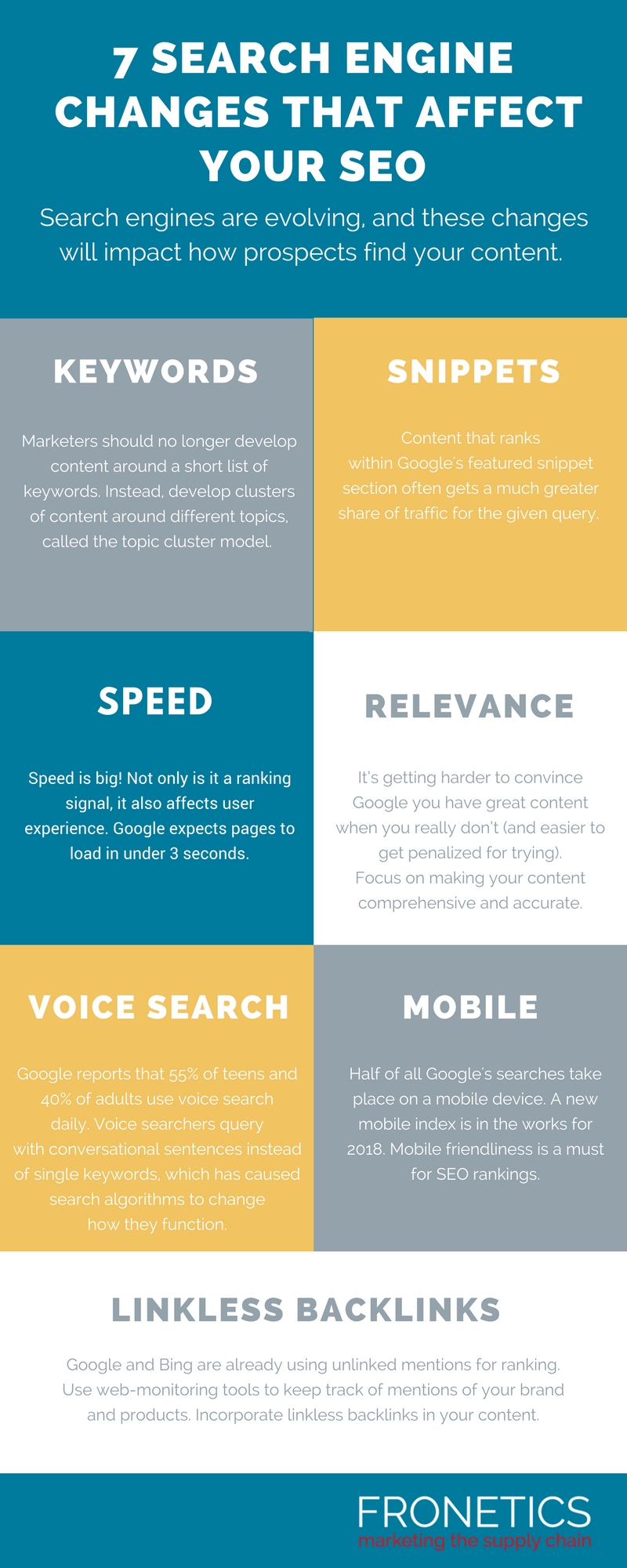
by Fronetics | Jul 14, 2020 | Blog, Covid-19, Marketing, SEO
Your company blog can be a goldmine for search engines. These strategies will give your old blog posts an SEO boost — without days of work.
When time and resources are in short supply, use them well. That leads us to your company blog. One of the quickest ways to get search engines to pay renewed attention to your website is to update old blog posts for SEO.
Why?
Google and other search engines reward new content. When your site is stagnant, Google takes note and will not crawl the site as often in search of updates. The result is a lower freshness score and lower rankings. But writing brand-new posts is time-consuming and may not be at the top of your priority lists when urgent matters demand attention. You need a quicker solution where the bulk of the work is already done.
The fact is your library of old blog posts is a goldmine for SEO. Content drives traffic and leads long after it was published. A look at our own most-viewed posts in July shows a post from 2018 has suddenly sailed to the top our lists as well as Google’s search engine results pages (SERP), driven by searches for “benefits of corporate social responsibility”.

But resting on old laurels is really not an option. Old posts that relay dated information can actually hurt your content marketing strategy. To get the most out of the hard work we pour into content creation here at Fronetics, we need to regularly extract the best of past blog posts and let them shine in a new light. Cue optimizing old blog posts for SEO.
Updating old blog posts for SEO comes with a range of benefits:
- It’s a win not only for the updated post but for the entire site since Google prioritizes frequent activity.
- It lets you rework keywords for improved organic search traffic.
- It helps you stay relevant in the eyes of your target audience (dated product launch posts do you no favors).
- It saves time as you don’t have to start from scratch every time you need to publish.
But how do you know which blog posts are worth repurposing?
Setting out to randomly update old blog posts for SEO makes little sense. Some, from years ago, may event warrant deleting, especially if they contain keywords that compete for attention with newer pieces. Rather, there are certain characteristics that make some posts more worthwhile to update than others. The point is not to spend hours rewriting the post or entirely changing its premise, but to give it good once-over that makes it useful again — and, by extension, drive improved SEO.
Here are a few themes to look for:
The number of inbound links: Posts with a lot of high-quality inbound links have something those without lack: authority. That feature gives these posts a better shot at ranking when you do a page refresh.
High conversion rates/low traffic: These posts have served you well in the past but something is amiss about their reach. If you can improve traffic with more relevant keywords, you have created a top lead generator.
High traffic: Some posts consistently draw lots of visitors, but are you putting your best foot forward? You can squeeze more value out of high-performing posts and extend their life span by giving your audience the most up-to-date information available. If conversion rates are low, you may find revising the Calls-to-Action (CTA) could have a big impact.
Ranking opportunities: Does the post rank on, let’s say, page 5 of search results? It can make it a good candidate for updating. Free tools like Moz Keyword Explorer or Ubersuggest can help you identify alternative keywords that could help lift the post to a better position.
Trending topics: If your business keeps getting questions about a certain topic that you covered but that now sits buried on the blog, a refresh means a chance to capture those search queries. It is also a better option than creating a new, duplicate post that could hurt search rankings.
Next question: What exactly should you do to SEO optimize old blog posts?
1. Evaluate keywords
Adding content to target new keywords is the No. 1 priority of marketers who update old blog posts for SEO, according to a Databox survey. Again, free SEO tools can help you take proactive steps to improve the keyword focus of your piece. Use Google Search Console, for instance, to identify keywords that the post is already ranking for and that potentially outperform the original keyword. Even a small tweak could give the post a boost.
2. Rewrite headlines, subheads, meta description, and intro
Once you have nailed down one or two long-tail keywords that match the intent of your target reader, incorporate them into the headline (H1), subheads (H2), and meta description. To underscore the freshness of the piece, rework the first paragraph and include the keyword. If you are sticking with the original keyword since it is already ranking well, make targeted alterations to potentially draw even more traffic and check back in to see how it performs a few weeks later.
3. Find new internal links
What has happened on your site recently? Internal links to old product pages and resources need to go. Improve the user experience and boost SEO at the same time by linking to your newest and most relevant work. Internal links give search engines a road map that benefits both the post that you’re working on and the pages that you’re linking to. And, while you’re at it, make sure there are no broken links. Do it manually or let Check My Links do the work.
4. Update stats and link to new research
Few things will make me leave a page as fast as old stats. Multiply that tendency by X number of readers, and your post will gradually lose its authority and keyword ranking. A quick search should identify more up-to-date information from outside industry sources. In a fast-moving industry like the supply chain, new reports are usually not hard to come by. Add an expert quote or two, link to new research, and you’re on the way to re-establishing the page as a trusted, quality source in the eyes of crawling search engines.
The supply chain stuff is really tricky. — Elon Musk
5. Add images and video
Time on page matters to SEO. And the more that draws visitors to stick around on the page, the better. Again, if time is limited, there are quick ways to update old posts for SEO. Consider adding a quick infographic, more engaging imagery, pull quotes, and anything else that is readily available, like a video produced for another part of your page. High-quality visuals also send a strong message of professionalism and trustworthiness that raise the profile of your blog in general. Remember to add alt texts that include the keyword.

6. Combine posts to turn the focus on high performers
Do you have posts with similar themes, concepts, and keywords? They may be competing with each other, eroding traffic and ranking for all. Here is your chance to pull segments of the weaker posts and add them to the higher performer (redirect the old posts to the new updated post). The benefits are twofold: the elimination of duplicate content and a content-rich new post which search engines favor.
7. Set a new publication date but don’t change the URL
Your work is almost done. Changing the URL, however, is generally not recommended. It requires a 301 redirect and means the loss of the authority the post has built up on your website. Instead, change the publication date, set it live, and share on social channels.
The bottom line
Optimizing old blog posts for SEO takes the pressure off producing new content when other tasks are calling. Even during less busy times, it is an integral feature of any content marketing strategy. The benefits are simply too good to pass up.

Read more:

by Fronetics | Feb 27, 2019 | Blog, Marketing, SEO, Website Development
SEO helps your website rank higher in search engine results pages. Here are the SEO basics to get your website performing better and in front of your target audience.
Highlights:
- SEO stands for search engine optimization — that much has stayed the same. It refers to techniques that help your website rank higher in search engine results pages.
- SEO works by optimizing a website’s pages, conducting keyword research, and earning inbound links.
- To rank well in the long term, build your SEO marketing strategy around topics, not keywords.
Video transcript:
I’m Jennifer Yim and I’m the Director of Strategy here at Fronetics. Today’s topic is SEO. SEO seems pretty straightforward. You pick a few keywords and your page is magically optimized for SEO, right? Not quite.
People understand the basic principles of SEO, but a lot has changed in the last decade. Let’s take a look at the basics to get your site ranking higher.
SEO stands for search engine optimization — that much has stayed the same. It refers to techniques that help your website rank higher in search engine results pages. This makes your website more visible to people who are looking for solutions that your brand, product, or service can provide by search engines like Google, Yahoo!, and Bing.
What hasn’t stayed the same are the techniques we use to improve our rankings. This has everything to do with the search algorithms that these companies constantly change.
SEO works by optimizing a website’s pages, conducting keyword research, and earning inbound links. You can generally see results of SEO efforts once the webpage has been crawled and indexed by a search engine.
There are a ton of ways to improve the SEO of your site pages. Search engines look for elements including title tags, keywords, image tags, internal link structure, and inbound links.
Search engines also look at site structure and design, visitor behavior, and other external, off-site factors to determine how highly ranked your site should be in their results pages.
To rank well in the long term, build your SEO marketing strategy around topics, not keywords. If you do that, you’ll find you can naturally optimize for important keywords, anyway. Understanding your target audience and what interests them is key to attracting relevant visitors to your website through search engines.
For more tips on improving SEO and building your digital marketing strategy, visit us at Fronetics.com.
Related posts:


by Fronetics | Feb 13, 2019 | Blog, Content Marketing, Marketing, SEO
Search engines are constantly changing, but these 5 tips will ensure that supply chain marketers can boost SEO in 2019.
Highlights
- People are changing how they search, and search engines are adapting accordingly.
- Simple changes to the structure of your site can have a big impact on your search engine rankings.
- Sites rich in quality content, like blogs and video, are poised to rank high for relevant search queries.
If there’s one constant when it comes to writing to boost Search Engine Optimization (SEO), it’s change. As users change the way they search online, search engines are continually adapting their algorithms to meet their needs. While it’s easy to get overwhelmed, it’s important for supply chain marketers to stay up-to-date and adapt their content strategy to boost SEO.
The year is just getting into full swing, and it’s a great time for savvy marketers to look ahead and make strategic decisions for SEO in 2019. These five tips will help you get ahead of the curve.
5 ways to boost SEO in 2019
1) Cluster content
Gone are the days of keyword rankings. Rather than prioritizing keyword focus, search engines have shifted to rewarding sites that produce strong content and arrange it in focused, niche topics.
Cluster content, a method of on-site SEO, might sound daunting. But it doesn’t require reinventing the wheel, just changing the structure of your site. For a detailed look at topic clusters and pillar content, check out part three of our four part series on writing for SEO.
We’ll give you the short version here: Select several core topics that most closely align with your brand, and reflect the knowledge you have to share. Evaluate your existing content, and categorize it based on which core topic or topics it falls under. Going forward, keep these core topics top of mind when planning and creating content. Next, arrange your site to reflect core topics with content clustered and linked from pillar pages.
2) Use header tags
As they become more and more sophisticated, search engines increasingly mirror human preferences. It doesn’t take an expert to tell you that text is more accessible to the eye when broken up by relevant subheadings — and search engines are no different. Headings make your text easier to skim and allow search engines to pick out content relevant to search queries.
Subheadings make your site more visually appealing, orienting readers and providing structure within your content. Remember that you’re creating headings for the dual purpose of guiding readers and optimizing for search engines. For this reason, stick to headings that are short and informative, reflecting the content below them, rather than teasing your readers with click-baity phrases.
[bctt tweet=” Stick to headings that are short and informative, reflecting the content below them, rather than teasing your readers with click-baity phrases.” username=”Fronetics”]
3) Blog
This one is evergreen. We’ve been writing for years about how blogging is crucial for supply chain companies, for all kinds of reasons — not the least of which is SEO. If increased lead generation and site engagement isn’t reason enough, you should know that blogging is one of the best ways to boost SEO.
A blog is your space for high-quality content that’s fresh, well-researched, and relevant. If you’re choosing your topics based on the needs and preferences of your target audience, chances are, you’re creating content that is perfectly aligned to search engine queries.
4) Make sure your page speed is high
Page speed is crucial for boosting SEO. If your page is loading slowly, Google logs it, and your ranking suffers. Not only that, visitors who do click on your site will be frustrated and turn away.
In fact, research shows that 40% of visitors will abandon sites where the page takes longer than three seconds to load.
One of the best ways to improve page speed is to switch to HTTP/2. If you haven’t already, switching your site from HTTP/1.1 (which has been the norm since 1999) is crucial. HTTP/2 was first published in 2015, with the goal establishing a faster, more secure internet. Search Engine Journal has published this great guide to HTTP/2, where you can learn more about the benefits, and how to switch.
5) Video
We’ve been talking about the benefits of video for a while now. Having video on your landing page will robustly improve your SEO. Video increases conversion rates, improves bounce rates, and boosts overall time on sites.
Search engines use bounce rate to rank pages — a low bounce rate and high user retention rate are indicators of strong content and high relevance to your target audience. Consequently, Google is strongly emphasizing these metrics in its ranking algorithm. Video keeps users on your site better than just about anything else and is therefore one of the most effective ways to boost SEO.
Related posts:


by Fronetics | Mar 7, 2018 | Blog, Content Marketing, Logistics, Marketing, Social Media, Strategy, Supply Chain
Linkless backlinks, or mentions of your business without a hyperlink to your webpage, are now a more effective way to improve your ranking with search engines.
For years Google has used backlinks to rank webpages. Backlinks are any link on another website that points (or links) back to your website. Unfortunately, search engines began to use backlinks as a bit of a popularity contest: The more you had, the more popular your website became.
Businesses quickly understood the loophole in search engines’ algorithms. They could buy, influence or even create relationships with other industry businesses for the sole benefit of getting links to their websites. It didn’t take long for search engines to catch on.
Google has spent years reworking the way it ranks backlinks and trying to penalize brands that pay for or create free links through unethical relationships. But where does that leave the rest of us that are working to create high-quality content in hopes of increasing our SEO rankings?
Linkless backlinks are the future of SEO rankings
You might be asking yourself what is a linkless backlink? Good question.
Linkless backlinks are mentions of your business or brand without a hyperlink to your webpage. In a keynote speech in September 2017, Gary Illyes, a webmaster trend analyst for Google, said:
“Basically, if you publish high-quality content that is highly cited on the internet — and I’m not talking about just links, but also mentions on social networks and people talking about your branding — then you are doing great.”
It all comes down to mentions of your brand on reputable websites. And I don’t just mean backlinks to your webpage. Other sites’ tweeting about your products or mentioning you on their Facebook News Feed can all lead to increased rankings on Google and other search engines. Sounds easy, right?
How to make linkless backlinks work for you
The principles that help you gain backlinks are still true for gaining linkless backlinks. You want to focus on creating the most accurate, high-quality content you can. Create videos and infographics for your website to add visual appeal. And collaborate with other industry leaders to reach new audiences.
But there are a few other tips you can use to help boost your SEO ranking with linkless backlinks.
3 tips for building a strategy for linkless backlinks
1. Work to increase brand awareness and reputation
The foundation of linkless mentions is reputation building. Search engines are looking for authentic mentions of products and brands in content that helps build authority around an industry topic.
Increase your brand awareness by growing your social media presence, by encouraging followers and loyal customers to write online reviews of your products and services, and by participating in collaborative content marketing.
2. Track brand awareness and mentions
You’re working hard to create content that has a far reach across many platforms. It’s a key step in gaining exposure among potential customers and earning new business. This process is called brand awareness, the extent to which consumers are familiar with your brand. And for linkless backlinks, it’s imperative that you’re tracking all of your brand mentions, not just links.
There are several tools to help you track brand mentions online. Here at Fronetics, we prefer the ease of Google Alerts, which sends you a message when someone mentions your brand online. We also use Hootsuite, with which you can track brand mentions, as well as keywords and phrases, across all of your social media platforms.
3. Stay on top of negative mentions
Blog comment sections and social media channels offer an open avenue for customers to discuss their thoughts about your company for all the world to see. And, unfortunately, one negative comment can be infinitely louder than one hundred positive ones. The potential impact it could have on business is scary.
But that doesn’t mean you should delete or ignore every unfavorable brand mention. In fact, companies can use negative online comments as an opportunity to exhibit top-notch customer service and much-appreciated transparency in the way they do business.
Be diligent in monitoring brand mentions and respond quickly to resolve any issues that arise. Responding promptly and effectively to negative feedback online shows your commitment to customer service and transparency.
The art of SEO building is a tough craft to master. As algorithms evolve, it’s important for brands to stay aware of these changes and focus on what they can do to help boost their rankings.
The more buzz around your brand, the better your ranking will be. So make sure you’re utilizing all the different ways to help boost your SEO ranking, including linkless backlinks.
Need more help with SEO? We’ve done the research, so you don’t have to. Have a look.
Related posts:


by Fronetics | Feb 19, 2018 | Blog, Content Marketing, Logistics, Marketing, Supply Chain
Search engines are evolving, and these changes will have big impacts on how searchers find your content. Here are 7 changes that will affect your SEO.
Internet users are changing how they search, and in response, search engines are changing how they rank content. Newer, more sophisticated algorithms have had big impacts on SEO rankings and the changes haven’t stopped there. Search engines are working around the clock to improve how content ranks for their users. Google and Bing want to ensure its readers are getting the quality content they deserve.
What does this mean for your SEO? It can be very challenging to understand all of the factors that go into a search engine’s algorithm for rankings. Google has over 205 factors that play a part in determining where you content lands in a search and they’re always changing. Instead of worrying about all of those components, here are 7 changes that have big impacts and are easy to integrate into your content.
7 search engine changes you need to know: infographic

Changes to the way search engines work do present a challenge for content creators writing for SEO. But keeping pace with the ever-changing technology is key to keeping your content relevant. Keeping these 7 key changes in mind, content writers can work to integrate these changes into their new content, as well as update older content.
Ultimately, the best way to improve your SEO is through your content. Quality content that is valuable to your target audience should be your biggest priority. With good content and keeping these 7 changes at the forefront, you will be able to optimize your posts and increase the likelihood internet searchers will find them.
Related posts:












